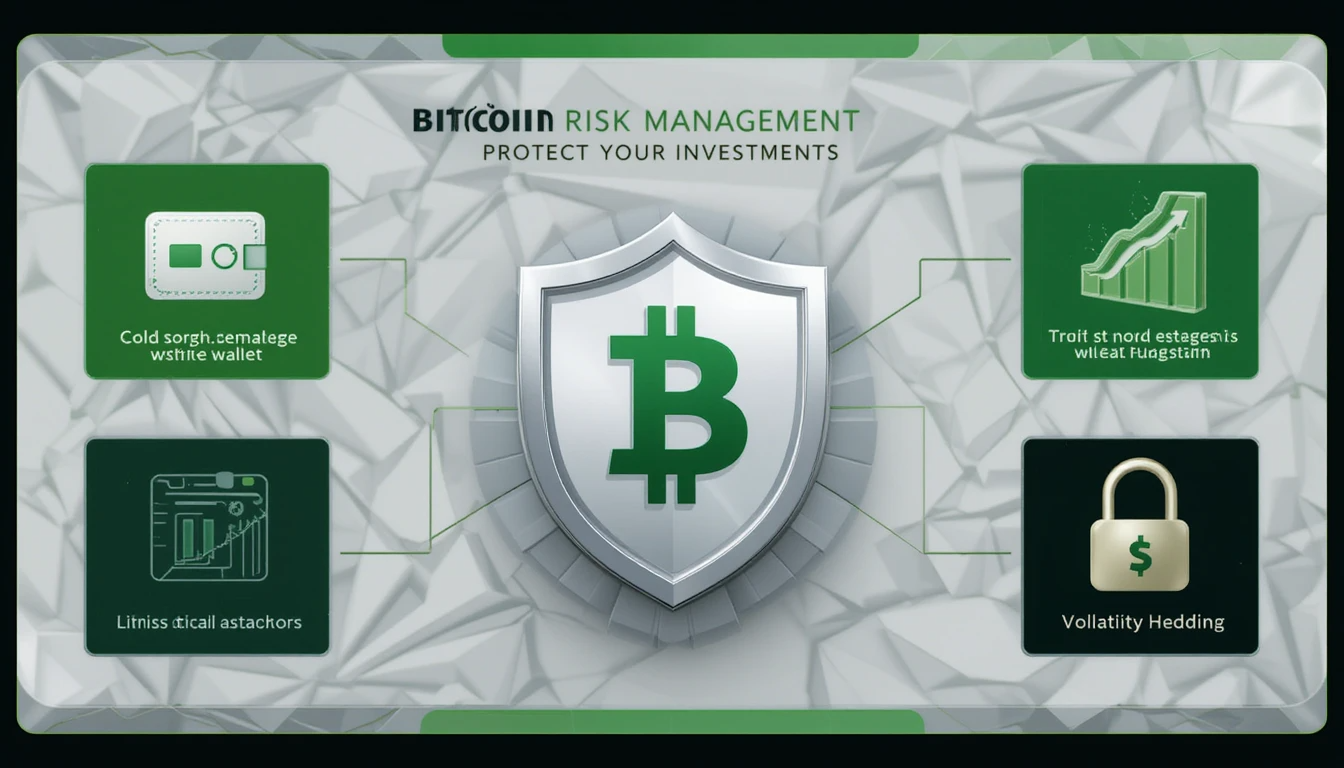
Bitcoin (BTC) has revolutionized investing, soaring past $100,000 by late 2024 and offering unparalleled opportunities for wealth creation. However, its volatility and unique challenges make Bitcoin Risk Management essential to secure crypto investments. Whether you’re a long-term hodler or a new investor, understanding how to manage bitcoin risk safeguards your portfolio against losses while maximizing gains. This guide provides actionable bitcoin safety tips and strategies for crypto portfolio protection, tailored for the dynamic crypto landscape of 2025. Let’s explore how to protect your Bitcoin investments with confidence and foresight.
Why Bitcoin Risk Management Is Crucial in 2025
Bitcoin’s meteoric rise—from $0.0008 in 2010 to six figures—comes with equally dramatic risks. Price swings, regulatory uncertainty, and security threats underscore the need to manage bitcoin risk. As we head into 2025, factors like post-halving volatility, evolving laws, and growing cyber threats amplify these challenges. Bitcoin Risk Management isn’t just about avoiding losses—it’s about ensuring your secure crypto investments thrive in a volatile market.
The Stakes Are High
-
- Volatility: BTC can drop 50%+ in weeks (e.g., $69,000 to $16,000 in 2021–2022).
-
- Security: Hacks and scams have cost investors billions—40% of BTC is lost or dormant.
-
- Regulation: 2025 could bring new rules impacting BTC’s legality.
-
- Opportunity Cost: Poor risk management limits your ability to capitalize on rallies.
Effective crypto portfolio protection turns these risks into manageable hurdles, preserving your Bitcoin wealth.
Understanding Bitcoin Risks
To master Bitcoin Risk Management, you must first identify the risks threatening your secure crypto investments. Here’s what you’re up against:
1. Market Volatility
Bitcoin’s price can surge or crash unpredictably, driven by sentiment, macroeconomic trends, or halving cycles.
2. Security Threats
Hacks, phishing, and exchange failures put your BTC at risk—e.g., the 2014 Mt. Gox collapse lost 850,000 BTC.
3. Regulatory Uncertainty
Governments could impose bans, taxes, or restrictions, affecting BTC’s value and accessibility.
4. Operational Risks
Lost private keys or hardware failures can lock you out of your funds permanently.
5. Counterparty Risk
Storing BTC on exchanges or with third parties introduces reliance on their solvency and security.
Knowing these risks is the first step to manage bitcoin risk and implement bitcoin safety tips for crypto portfolio protection.
Strategies for Bitcoin Risk Management in 2025
Here are proven strategies to manage bitcoin risk, ensuring secure crypto investments and robust crypto portfolio protection in 2025.
1. Diversify Your Crypto Holdings
While Bitcoin is a powerhouse, over-reliance heightens risk. Diversify to reduce crypto risk:
-
- Portfolio Mix: 60% BTC, 20% ETH, 10% stablecoins (USDC), 10% altcoins (e.g., SOL).
-
- Stablecoins: Hedge volatility with USDC or USDT, earning 3–8% via staking on Aave.
-
- Altcoins: Add growth assets like Chainlink (LINK) or Polygon (MATIC).
Why It Works: Diversification spreads exposure, a foundational bitcoin safety tip for Bitcoin Risk Management.
2. Use Dollar-Cost Averaging (DCA)
DCA involves investing fixed amounts regularly (e.g., $100/month), smoothing out Bitcoin’s volatility—a key way to manage bitcoin risk.
-
- Example: $100/month from 2020 ($10,000/BTC) to 2024 ($100,000/BTC) = 0.058 BTC, worth $5,800 on a $4,800 investment.
-
- Platforms: Coinbase, Binance, or Kraken automate DCA.
Why It Works: Avoids panic buys or sells, securing bitcoin profits 2025 with steady crypto portfolio protection.
3. Secure Your Bitcoin with Cold Storage
Protecting your BTC from hacks is a cornerstone of Bitcoin Risk Management.
-
- Hardware Wallets: Ledger or Trezor store keys offline—ideal for secure crypto investments.
-
- Multi-Signature: Require multiple approvals (e.g., 2-of-3 keys) to access funds.
-
- Backup: Engrave seed phrases on steel plates, stored in a safe.
Why It Works: Cold storage eliminates online vulnerabilities, a top bitcoin safety tip for 2025.
4. Limit Exchange Exposure
Leaving BTC on exchanges risks loss from hacks or insolvency (e.g., FTX’s 2022 collapse).
-
- Strategy: Move BTC to personal wallets after buying—use exchanges only for trading.
-
- Trusted Platforms: Stick to Binance, Coinbase, or Kraken with strong security (2FA, insurance).
Why It Works: Reduces counterparty risk, ensuring crypto portfolio protection and secure crypto investments.
5. Hedge Against Volatility
Use financial tools to manage bitcoin risk during turbulent markets:
-
- Stablecoins: Park funds in USDC during downturns, then rebuy BTC at lower prices.
-
- Options/Futures: Advanced investors can hedge via Deribit or Binance (consult a pro).
-
- Cash Reserves: Keep 10–20% in fiat for buying dips.
Why It Works: Hedging preserves capital, aligning with bitcoin safety tips for Bitcoin Risk Management.
6. Stay Ahead of Regulations
Regulatory shifts in 2025 could impact BTC. Proactive crypto portfolio protection includes:
-
- Monitor News: Follow CoinTelegraph or X for updates on laws.
-
- Tax Compliance: Use Koinly to track gains—penalties hurt profits.
-
- Global Diversification: Hold BTC in jurisdictions with crypto-friendly policies (e.g., Switzerland).
Why It Works: Prepares you for legal changes, a critical aspect of manage bitcoin risk.
Tools for Bitcoin Risk Management
Leverage these 2025 tools to enhance Bitcoin Risk Management:
-
- CoinStats: Monitor BTC and portfolio performance in real-time.
-
- Ledger Live: Manage cold storage securely.
-
- Blockfolio: Set price alerts to act on dips or peaks.
-
- Koinly: Simplify tax reporting for secure crypto investments.
These productivity tools remote streamline crypto portfolio protection, boosting remote work efficiency.
Bitcoin Safety Tips for 2025
Here are practical bitcoin safety tips to manage bitcoin risk and protect your investments:
1. Enable Two-Factor Authentication (2FA)
-
- Use authenticator apps (e.g., Google Authenticator) on exchanges and wallets—avoid SMS.
2. Avoid Public Wi-Fi
-
- Trade or access wallets only on secure, private networks to prevent phishing.
3. Verify Platforms
-
- Double-check URLs (e.g., binance.com, not binanace.com) to avoid scams.
4. Split Storage
-
- Divide BTC across multiple wallets (e.g., 50% Ledger, 50% Trezor) for redundancy.
5. Test Small Transactions
-
- Before moving large sums, send a small amount to confirm wallet addresses.
These habits reinforce secure crypto investments and Bitcoin Risk Management.
Sample Bitcoin Risk Management Portfolio
Here’s a balanced approach for crypto portfolio protection in 2025:
-
- 60% Bitcoin (BTC): Core holding, stored in cold wallet.
-
- 20% Ethereum (ETH): Staked for passive income.
-
- 10% USDC: Liquidity and stability.
-
- 10% Solana (SOL): Growth potential with moderate risk.
Why It Works: Combines BTC’s strength with diversified assets to reduce crypto risk.
Risks to Watch in 2025
Stay vigilant with these crypto risk factors impacting Bitcoin Risk Management:
1. Market Corrections
-
- Mitigation: DCA and stablecoin hedges cushion 50%+ drops.
2. Exchange Hacks
-
- Mitigation: Cold storage and minimal exchange balances.
3. Regulatory Bans
-
- Mitigation: Diversify into compliant altcoins (e.g., ETH).
4. Quantum Computing
-
- Mitigation: BTC’s Taproot upgrade counters future threats—stay updated.
Proactive bitcoin safety tips turn risks into opportunities for secure crypto investments.
2025 Trends Shaping Bitcoin Risk Management
These 2025 tools trends influence how you manage bitcoin risk:
-
- Institutional Custody: Firms like Fidelity offer secure storage options.
-
- Layer-1 Upgrades: Taproot enhances BTC’s privacy and security.
-
- Stablecoin Growth: More options for hedging volatility.
-
- Regulatory Clarity: Clearer laws could stabilize markets, aiding crypto portfolio protection.
Adapt your bitcoin investment strategy to these shifts for maximum safety.
Conclusion: Protect and Profit with Bitcoin Risk Management
Bitcoin Risk Management is your shield against the crypto wild west, ensuring secure crypto investments in 2025. By diversifying, securing your BTC, using DCA, and staying informed, you can manage bitcoin risk while positioning for big gains. These bitcoin safety tips and crypto portfolio protection strategies safeguard your wealth in a volatile market, blending caution with opportunity.
Start today: secure your BTC in a cold wallet, set up DCA on Binance, and diversify with a small altcoin stake. With smart Bitcoin Risk Management, your investments aren’t just protected—they’re primed to prosper!




